From humble beginnings to a global fashion phenomenon, the t-shirt, or teeshirt as some call it, has a rich history that is a tale of comfort, rebellion, and personal expression. This iconic wardrobe staple, with a t-shirt origin dating back to the early 20th century, has evolved from an undergarment worn by sailors and laborers to a versatile piece of clothing that represents individual style and cultural movements. The t-shirt meaning and what the ‘t’ in t-shirt stands for is a testament to its shape, explaining why t-shirts are called t-shirts. The history of the t-shirt is a significant chapter in fashion history.
Origins of the t-shirt
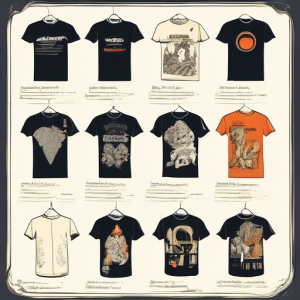
The origins of the t-shirt, or undershirt as it was initially known, can be traced back to the late 19th century when it was primarily used as an undergarment. Made from lightweight cotton fabric with a basic t-shirt design and round neck, it provides a comfortable layer between the skin and outer clothing. The short-sleeved t-shirt was worn primarily by laborers and soldiers, who appreciated its practicality and ease of movement.
In the early 20th century, the t-shirt, often referred to as an undershirt, gained popularity among sailors in the US Navy. Its short sleeves and lightweight fabric made it ideal for warm weather. The Navy-issued t-shirts were plain white, allowing easy identification of sailors who fell overboard. This association with the Navy led to the term ‘t-shirt’ being coined.
As the t-shirt made its way into mainstream fashion, it became a symbol of rebellion against societal norms and a canvas for protest art. In the 1950s, Marlon Brando’s portrayal of a rebellious biker in ‘The Wild One’ (1953) catapulted the t-shirt into the limelight. Brando’s character, adorned in a white t-shirt and jeans, represented a new wave of youthful defiance and individuality, making the t-shirt one of the most recognized cultural icons.
The invention of the T-shirt
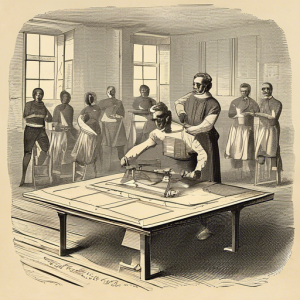
The exact identity of the inventor of the t-shirt remains a mystery. While there isn’t a single individual credited with its invention, the t-shirt evolved through a series of innovations and adaptations. Some believe that it was the U.S. Navy who first introduced the t-shirt as an undergarment for their sailors in the early 1900s. Others attribute its invention to European laborers who needed a practical and lightweight garment for their work. Regardless of who invented the t-shirt or when were t shirts invented, its impact on fashion is undeniable.
Regardless of its origins, it is evident that the t-shirt was a truly groundbreaking invention. This simple yet ingenious garment revolutionized the fashion industry and became a staple in wardrobes worldwide. With its straightforward design and adaptable nature, the t-shirt quickly became easily attainable for individuals from diverse backgrounds, transcending social and economic barriers. Moreover, its functionality and convenience swiftly gained popularity among the masses, solidifying its status as a game-changing innovation that continues to shape the way we dress and express ourselves today.
Why are t-shirts called t-shirts

T-shirts are called T-shirts because, when they are laid out flat, their shape resembles the letter T. This distinct and easily identifiable characteristic is what gives them their unique and recognizable name. The T-shape of these garments is a defining feature that sets them apart from other types of shirts. The letter T is formed by the intersection of the sleeves and the body of the shirt, creating a silhouette that is instantly recognizable. This clever naming convention has become widely accepted and is now synonymous with this particular style of shirt. So, the next time you put on a T-shirt, take a moment to appreciate the ingenuity behind its name, which pays homage to its distinctive shape.
Evolution of the t-shirt through different eras

In the 1950s the t-shirt gained popularity as outerwear. Marlon Brando’s iconic portrayal of Stanley Kowalski in ‘A Streetcar Named Desire’ showcased the rugged masculinity of the t-shirt, and it quickly became a symbol of rebellion and nonconformity, further solidifying its status as one of the most influential cultural icons.
In the 1960s, the t-shirt became an integral part of the counterculture movement, serving as a canvas for self-expression. Music festivals like Woodstock and the rise of rock ‘n’ roll brought about a shift in fashion, with tie-dyeing t-shirts and band merchandise becoming popular among the youth. The t-shirt, with slogans, album covers, and psychedelic artwork adorning its fabric, also emerged as a medium for message t-shirts.
The 1970s saw the t-shirt continue to evolve, becoming a symbol of cultural icons and the emergence of punk and disco subcultures. Punk rock bands like The Ramones and Sex Pistols adopted t-shirts as a symbol of their rebellious ethos, often using them as message t-shirts. The popularity of disco music gave rise to glittery, sequined t-shirts, reflecting the glamour and excess of the era.
The 1980s marked the era of graphic t-shirts, with iconic designs inspired by pop culture, sports, and political movements, setting new t-shirt trends. The advent of screen printing technology, using plastisol ink, made it easier to mass-produce t-shirts with intricate designs, paving the way for the explosion of graphic tees.
Popular culture and the T-shirt
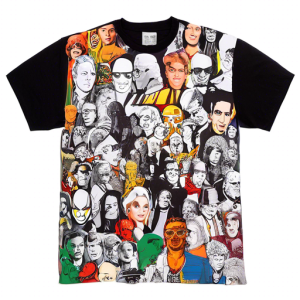
The t-shirt’s popularity continued to soar in the 1990s and early 2000s, with pop culture playing a significant role in shaping its image. Movie franchises like Star Wars and TV shows like Friends gave rise to a wave of t-shirts featuring iconic quotes and characters, often used as message t-shirts. These cultural icons, including musicians and actors, often seen sporting their merchandise, also played a part in popularizing t-shirts.
Social media further propelled the t-shirt into the mainstream, with influencers and fashion bloggers showcasing their style through carefully curated t-shirt ensembles, setting new t-shirt trends. The rise of online shopping made it easier for consumers to access a wide variety of t-shirt designs, allowing them to express their individuality and connect with like-minded communities.
T-shirt printing techniques
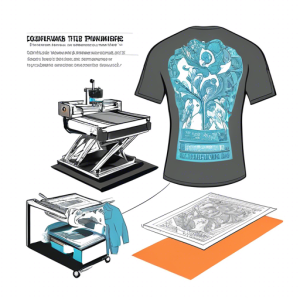
T-shirt printing techniques have evolved over the years, offering endless possibilities for customization and design. Screen printing, the most common method, involves applying layers of plastisol ink onto a mesh screen to create a design. This technique allows for vibrant colors and intricate details, making it ideal for mass production.
Digital printing, also known as direct-to-garment printing, utilizes inkjet technology to print designs directly onto the fabric. This technique is ideal for complex designs and small print runs, as it offers high-resolution results with minimal setup time.
Other printing techniques include heat transfer, which uses heat and pressure to transfer designs onto the fabric, and sublimation printing, which involves transferring designs onto specially coated paper and then onto the t-shirt using heat.
Iconic t-shirt designs and slogans
![]()
Throughout history, certain t-shirt designs and slogans have become cultural icons, representing cultural movements and capturing the spirit of the times. One such example is the message t-shirt, ‘I ♥ NY’, created in 1977 as part of a marketing campaign to promote tourism in New York City. This simple yet powerful design has become synonymous with the city itself, representing love and unity.
Band t-shirts, serving as cultural icons, have also left an indelible mark on t-shirt history. From The Rolling Stones’ iconic tongue logo to Nirvana’s smiley face, these designs have become symbols of musical movements and fan loyalty. The Ramones’ classic presidential-style logo, featuring the names of the band members, has become an enduring symbol of punk rock, and a prime example of message t-shirts.
Political and protest art movements have also utilized t-shirts as a means of spreading their message. The iconic ‘Hope’ t-shirt, designed by Shepard Fairey for Barack Obama’s 2008 presidential campaign, became a symbol of optimism and change. The ‘We Can Do It!’ Rosie the Riveter t-shirt, inspired by the World War II propaganda poster, has become a cultural icon and a symbol of female empowerment.
T-shirts as a form of self-expression

One of the t-shirt’s greatest strengths is its ability to serve as a blank canvas for self-expression. People can choose to wear message t-shirts that reflect their interests, beliefs, and personality. Whether it’s a band t-shirt, a sports team jersey, or a t-shirt with a witty slogan, individuals can use their clothing to communicate their identity to the world.
The rise of customizable t-shirts, a significant t-shirt trend, has further enhanced this aspect of self-expression. Online platforms and local print shops allow individuals to create their designs, incorporating personal photos, artwork, or messages. This level of customization gives people the opportunity to truly create a one-of-a-kind t-shirt that reflects their unique style and interests.
T-shirts in the fashion industry
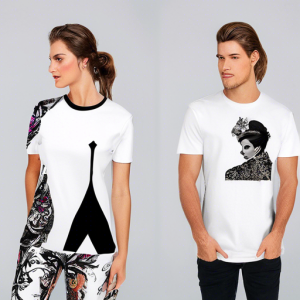
The t-shirt, a key player in fashion history, has transcended its humble beginnings to become a staple in the fashion industry. High-end designers have embraced the t-shirt as a canvas for their artistic visions, creating limited-edition pieces that blur the line between fashion and art. Collaborations between fashion brands and artists have produced highly sought-after t-shirts that fetch premium prices.
In recent years, sustainable fashion has gained traction, and t-shirts have become a pivotal point in the dialogue about ethical clothing. Brands are now exploring eco-friendly fabrics, such as organic cotton and recycled materials, to mitigate the environmental impact of t-shirt production. Moreover, fair trade practices and transparent supply chains are being implemented to ensure ethical manufacturing processes.
Sustainability and ethical issues in the t-shirt industry
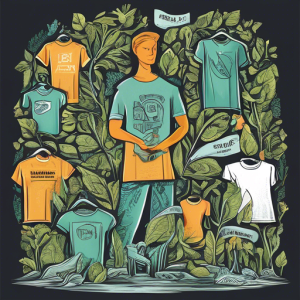
The t-shirt industry grapples with several sustainability and ethical challenges. The production of cotton, the primary fabric used in t-shirts, is resource-intensive and often involves the use of harmful pesticides. The manufacturing process also consumes vast amounts of water and energy, contributing to environmental degradation.
Moreover, the fast fashion culture has spurred overconsumption and a throwaway mentality, with many t-shirts ending up in landfills after only a few years. The production of cheap, disposable t-shirts often involves exploitative labor practices and low wages for garment workers.
To tackle these issues, sustainable fashion initiatives and ethical clothing brands are emerging. These brands prioritize transparency, fair wages, and environmentally friendly practices. They encourage consumers to make conscious choices by investing in high-quality, timeless t-shirts that are designed to last.
Conclusion: The future of the t-shirt

The t-shirt, a garment that has been around for centuries, has undergone a remarkable evolution. From its humble beginnings as an undergarment, it has now become a powerful symbol of self-expression and cultural movements. Over time, the fashion industry has faced numerous challenges, particularly in terms of sustainability and ethics. However, the t-shirt has proven to be adaptable and resilient, and it is expected to continue evolving in response to these concerns. Its rich fashion history is a testament to its enduring popularity and significance in our society.
In the future, as the t-shirt industry continues to evolve, we can anticipate a greater emphasis on sustainability. This means that more eco-friendly materials and production methods will be adopted, reducing the industry’s environmental impact. Additionally, advancements in digital printing technology will enable even more intricate designs and customization options for t-shirts. This will allow individuals to express their unique style and preferences through their clothing. Furthermore, the growing influence of e-commerce and social media will democratize the t-shirt industry, providing a platform for independent designers and small brands to showcase their creations and contribute to the latest t-shirt trends.
Ultimately, the t-shirt’s enduring popularity lies in its ability to serve as a blank canvas for self-expression. Whether it’s a classic white tee or a vibrant graphic design, the t-shirt offers a versatile platform for individuals to showcase their unique style and personality. In a world where fashion trends come and go, the t-shirt remains a timeless wardrobe staple that transcends time and cultural boundaries. With the advancements in technology, t-shirts have evolved to incorporate innovative printing techniques, allowing for even more intricate and detailed designs. However, at its core, the t-shirt will always be a medium for individuals to proudly wear their passions, beliefs, and identities on their sleeves—literally. This is especially evident in the popularity of message t-shirts, which provide a platform for wearers to express their views openly and spark conversations. Whether it’s a political statement, a witty slogan, or a powerful message, message t-shirts have become a powerful tool for self-expression and activism. From promoting social causes to showcasing personal interests, the t-shirt has become an integral part of our everyday lives, reflecting our values and allowing us to connect with like-minded individuals. As we navigate through the ever-changing landscape of fashion, one thing is certain: the t-shirt will continue to be a beloved and cherished garment, symbolizing individuality, creativity, and the power of self-expression.
The t-shirt, a versatile and timeless garment, has a rich history that has contributed to its enduring popularity among people of all ages and walks of life. It serves as more than just a piece of clothing; it is a blank canvas for self-expression and a link to the past. The t-shirt’s meaning of comfort and casual style has made it a wardrobe staple for countless individuals.
In conclusion, the enduring popularity of the t-shirt can be attributed to several factors. Firstly, its rich history plays a significant role in its appeal. From its humble beginnings as an undergarment in the early 20th century to its rise as a symbol of rebellion and counterculture in the 1960s, the t-shirt has become a cultural icon. Secondly, the t-shirt’s ability to serve as a canvas for self-expression is another key factor. Whether it’s through band logos, political slogans, or personal artwork, individuals can use t-shirts to showcase their identity and beliefs. Lastly, the t-shirt’s role in fashion and popular culture cannot be overlooked. From high fashion runways to streetwear brands, the t-shirt has become a staple in everyone’s wardrobe. As the industry continues to adapt to changing times, the t-shirt remains a versatile and beloved garment that holds exciting potential for the future.
